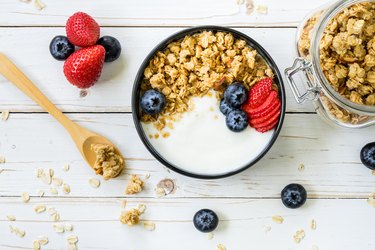
Following a 10-day diet or 10-day meal plan is a good kick-start if you're looking to shed excess pounds fast. Whether for an upcoming event or as part of an overall health goal, rapid weight loss may result from a strict meal plan, but a slow, steady pace is more sustainable for long-term health.
Tip
An extreme 10-day diet or adhering to any meal plan for extreme weight loss may not be the best solution for long-term health or weight-loss goals, whereas slow and steady is a more preferred and healthier way to get in shape.
Video of the Day
10-Day Meal Plan
Whether you're looking to shed extra pounds or simply looking to improve your health, following a 10-day diet or 10-day meal plan is a quick and simple way to start the process.
Video of the Day
The Cleveland Clinic recommends following a heart-healthy diet that includes plenty of fresh fruits and vegetables, whole grains, proteins, fiber as well as limiting the amount of sugar, carbohydrates and being mindful of portion sizes. Additionally, diets that reduce or eliminate carbs and sugar are especially popular for celebrities about to walk the red carpet or those who want to lose weight in a hurry.
The Mayo Clinic emphasizes the importance of following and eating a healthful diet, one which includes an equal ratio of healthy fats and proteins, carbohydrates, whole foods and fresh fruits and vegetables. The base of the Mayo Clinic Healthy Weight Pyramid focuses on generous amounts of healthy and unprocessed foods that contain a smaller number of calories in a large volume of food, emphasizing fruits and vegetables.
Eating low-energy, dense foods can help you lose weight by feeling full on fewer calories. Be mindful to make healthy choices in the other food groups, including whole-grain carbohydrates, lean sources of protein and heart-healthy unsaturated fats.
Read more: 10-Day Cleansing Diet
Detox Diets for Better Health
The U.S. Department of Agriculture (USDA) suggests following a diet that focuses on making healthy food choices. These include making half of your plate at each meal filled with vegetables and fruits. Also, adding fruit to meals as a part of a side and/or main dish along with opting for red, orange and dark, leafy green vegetables such as tomatoes, sweet potatoes, broccoli, kale, spinach and chard among others.
According to Harvard Health Publishing, a healthy plate means making the most of each meal. Make sure half of your plate is filled with vegetables or fruits, while opting for whole grains as one-quarter of the plate and protein as one-quarter. Stick to water, tea or coffee for calorie-free beverages at meals. Additionally, eating whole, unprocessed foods that are packed with protein and reducing the amount of refined sugar consumed can help you detox without drastic juicing.
Read more: The Best 2 or 3 Day Detox to Lose Weight
Make the Most of Macronutrients
Whole foods are made up of a combination of macronutrients and micronutrients. As explained by the USDA, macronutrients include carbohydrates, fat and protein. A diet based on macronutrients factors in the percentage combination or ratio of carbs, proteins and fats for total calories. USDA guidelines list these ranges as carbohydrates as 45 to 65 percent, protein as 10 to 35 percent and fat as 20 to 35 percent.
The American Council on Exercise (ACE) offers the following basic recommendations for determining which ratio or range of macronutrients is right for you based on individual needs and goals. According to ACE, 1 gram of carbohydrate is equivalent to 4 calories, providing fuel during high-intensity exercise.
Active individuals should aim for 45 to 55 percent total carbohydrates per day, while those participating in medium to high intensity training should go with 45 to 55 percent total carbohydrates per day. If you're looking to lose weight, choose 45 to 50 percent lower-glycemic carbohydrate sources, particularly later in the day.
ACE explains protein as being used for building, repairing and maintaining body tissues with 1 gram of protein equaling 4 calories. Active individuals should consume 10 to 15 percent total protein; those performing medium- to high-intensity training should have 20 to 30 percent total protein, and those seeking weight loss, 25 to 30 percent total protein.
Fat is what provides insulation, protects vital organs and reserves energy, with 1 gram equaling 9 calories. Active individuals should go for 25 to 35 percent total fat; medium- to high-intensity training requires approximately 30 percent total fat, and those looking for weight loss should aim for 20 to 25 percent total fat sources of unsaturated and essential fatty acids.
- U.S. Department of Agriculture: "Macronutrients"
- U.S. Department of Agriculture: "10 Tips for Make Better Food Choices"
- Mayo Clinic: "The Mayo Clinic Diet"
- Cleveland Clinic: "Heart Healthy Diet"
- Harvard Health Publishing: "Healthy Eating Plate"
- American Council on Exercise: "How to Determine the Best Macronutrient Ration for Your Goals"